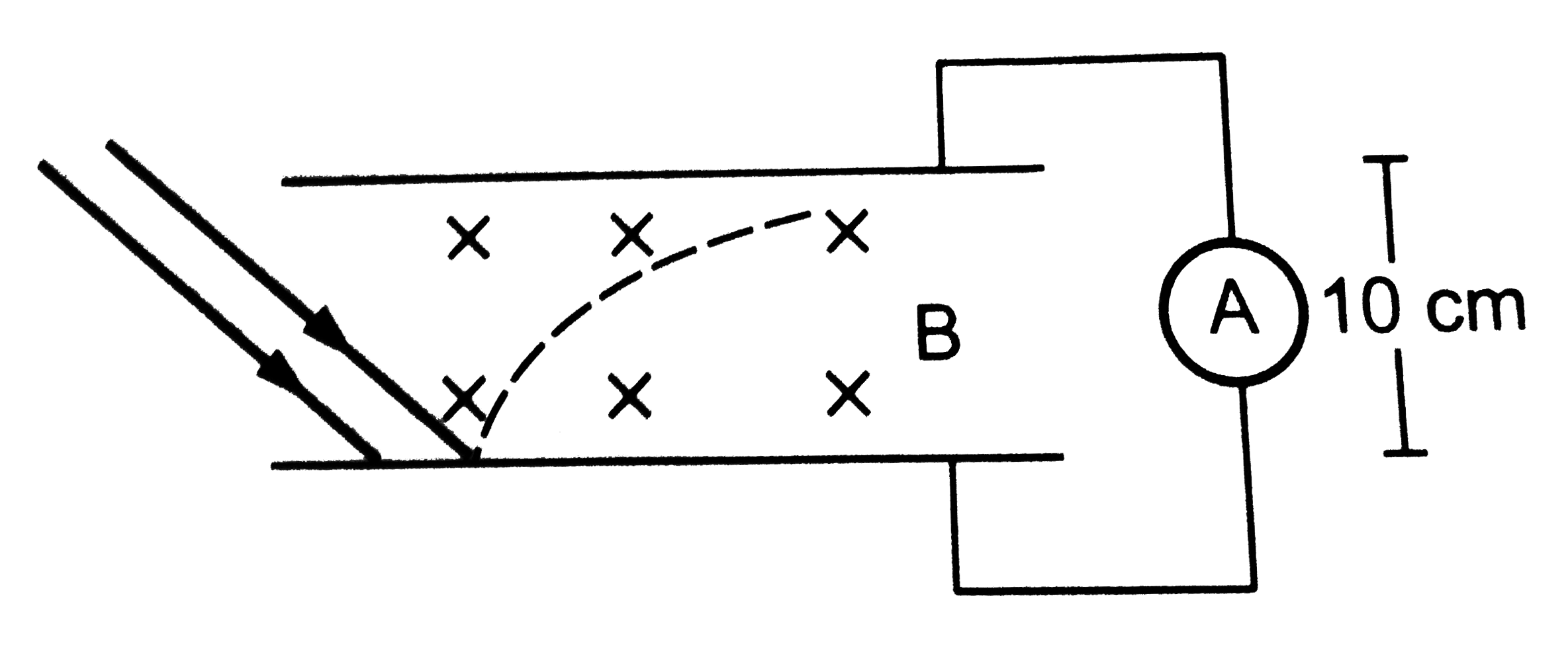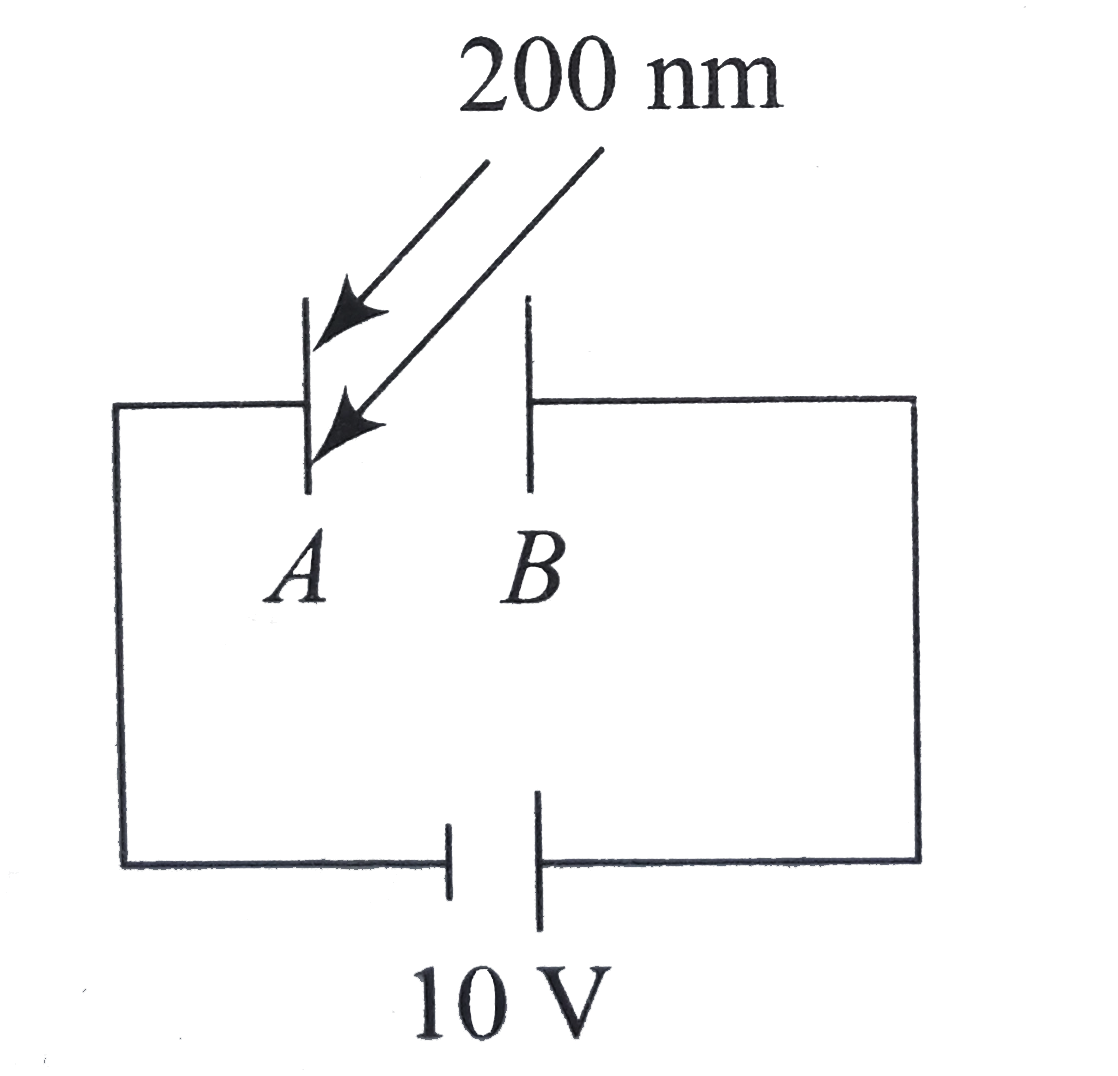In an experiment on photoelectric effect of light wavelength 400 nm is incident on a metal plate at rate of 5W. The potential of the collector plate is made sufficiently positive with respect to emitter so that the current reaches the saturation value. Assuming that on the average one out of every 106 photons is able to eject a photoelectron, find the photocurrent in the cirucuit.
The correct Answer is:Pλhc×106eA=3.2μA
No. of photons PEλ=Pλhc.s−1
no of photo electron s/s=Pλhc.1106
∴ photo current =Pλhc×106.e=5×800×10−9×(1.6×10−19)6.63×10−34×3×108×106A=3.2μA.
Topper's Solved these Questions
- BOOK - RESONANCE ENGLISHCHAPTER - ATOMIC PHYSICSEXERCISE - Exercise ( Part II : Only one one correct type)37videos
ATOMIC PHYSICS
- BOOK - RESONANCE ENGLISHCHAPTER - ATOMIC PHYSICSEXERCISE - Exercise (2) Only one option correct type30videos
ATOMIC PHYSICS
- BOOK - RESONANCE ENGLISHCHAPTER - ATOMIC PHYSICSEXERCISE - Solved miscellaneous problems14videos
ATOMIC PHYSICS
- BOOK - RESONANCE ENGLISHCHAPTER - ALTERNATING CURRENTEXERCISE - HIGH LEVEL PROBLEMS11videos
ALTERNATING CURRENT
- BOOK - RESONANCE ENGLISHCHAPTER - CAPACITANCEEXERCISE - High Level Problems16videos
CAPACITANCE
Similar Questions
In an experiment on photoelectric effect light of wavelength 400nm is incident on a metal plate at rate of 5W. The potential of the collector plate is made sufficiently positive with respect to emitter so that the current reaches the saturation value. Assuming that on the average one out of every 106 photons is able to eject a photoelectron, find the photocurrent in the circuit.
View SolutionA silver ball of radius 4.8 cm is suspended by a thread in a vacuum chamber, Ultraviolet light of wavelength 200nm is incident on the ball for some time during which a total light energy of 1.0×10−7 J falls on the surface. Assuming that on the average one photon out of every ten thousand is able to eject a photoelectron, find the electric potential at the surface of the ball assuming zero potential at infinity. What is the potential at the centre of the ball?
View SolutionA silver of radius 4.8cm is suspended by a thread in the vacuum chamber . UV light of wavelength 200nm is incident on the ball for some times during which a total energy of 1×10−7J falls on the surface . Assuming on an average one out of 1000 photons incident is able to eject electron. The potential on sphere will be
View SolutionIn photoelectric effect light of certain frequency (> threshold frequency ) is incident on a metal surfave whereby , an e− ( with certain K.E.) moves towards the collector plate and a flow of current is initiated . In order to stop the current flow, an opposite potential , on the two metal plates, is applied
A light of frequency 2.5×1015Hz is incident on a metal surface having work function 4 eV. The velocity of photoelectron is ( in cm s−1)View SolutionIn photoelectric effect light of certain frequency (> threshold frequency ) is incident on a metal surfave whereby , an e− ( with certain K.E.) moves towards the collector plate and a flow of current is initiated . In order to stop the current flow, an opposite potential , on the two metal plates, is applied
The work function of metal is 6eV . If light of frequency 1×1015Hz is incident on the metal , intensity of light is increased 4 times, thenView SolutionIn a photoelectric experiment, the collector plate is at 2.0 V with respect to the emitter plate made of copper ϕ=4.5. The emitter is illuminated by a source of monochromatic light of wavelength 200nm. Find the minimum and maximum kinetic energy of the photoelectrons reaching the collector.
View SolutionIn a photoelectric experiment, the collector plate is at 2.0V with respect to the emitter plate made of copper (ϕ)=4.5eV). The emitter is illuminated by a source of monochromatic light of wavelength 2000 Ånm.
View SolutionIn an experiment on photoelectric effect, the emitter and the collector plates are placed at a separation of 10cm and are connected through an ammeter without any cell. A magnetic field B exists parallel to the plates. The work function of the emitter is 2.39 e V and the light incident on it has wavelengths between 400nm and 600nm. Find the minimum value of B for which the current registered by the ammeter is zero. Neglect any effect of space charge.
 View Solution
View SolutionA beam of light of wavelength 400nm and power 1.55 mW is directed at the cathode of a photoelectric cell. If only 10% of the incident photons effectively produce photoelectrons, then find current due to these electrons. (given hc=1240eV−nm,e=1.6×10−19C)
View Solution
In Fig. electromagnetic radiations of wavelength 200nm are incident on a metallic plate A. the photoelectrons are accelerated by a potential difference of 10 V. These electrons strike another metal plate B from which electromagnetic radiations are emitted. The minimum wavelength of emitted photons is 100nm. If the work function of metal A is found to be (×x10−1)ev, then find the value of x. (Given hc=1240eV nm)View Solution

